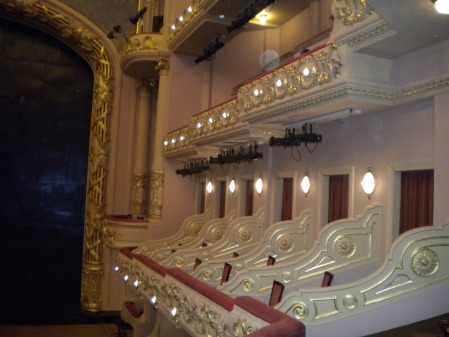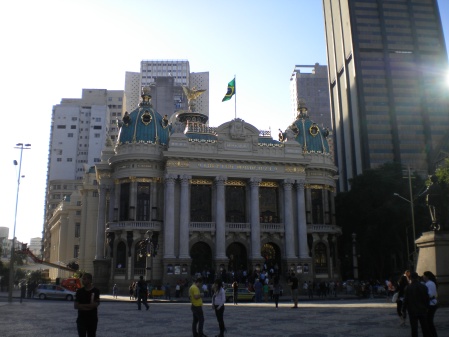Last week the city of Rio de Janeiro reopened the stunningly beautiful Theatro Municipal after more than two years of renovation work. Built between 1906 and 1909, the theatre is one of the landmarks of downtown Rio. It faces across the extensive Cinelândia plaza looking out at Guanabara Bay and the Sugarloaf Mountain. On the west side of the plaza sits the stately City Council Chamber and on the east side is the broad Rio Branco Avenue with the National Library and National Museum of Fine Arts just across the street from the theatre. Both were also built in the first decade of the twentieth century in the same architectural style, symbols of the “new” Rio de Janeiro.
In the late nineteenth and early twentieth century Rio was the political, economic, and cultural capital of the nation. The Brazilian elites consciously strived to emulate Europe, especially England and France. During this so called belle époque (beautiful age) the elites physically transformed Rio de Janeiro much the way the Parisian elite had transformed Paris a half-century earlier. Mayor Francisco Pereira Passos leveled sections of the city center to open wide boulevards, in particular, what today is the massive Avenida Getúlio Vargas and the street that runs perpendicular to it, the Avenida Rio Branco (known as the Avenida Central in the early twentieth century). Many of the areas that Pereira Passos destroyed were tenements and slums in the central parts of the city and some of the displaced inhabitants migrated into the earliest favelas on Rio hillsides.
The Theatro Municipal was built in the style of European opera houses complete with marble, chandeliers, frescoes, and gold leaf. French and Italian designers and artisans completed much of the art work. The restored building lacks a few finishing touches, but it is a jewel. New gold leaf, completely reconstructed chandeliers, and restored frescoes shine and sparkle. This belle époque opera house (with 2100 seats) also has the intimacy that is missing in so many modern facilities. Even in the upper galleries (of the four levels), one can still feel reasonably close to the performers and the acoustics are excellent.
On Friday night I attended Giuseppe Verdi’s Il Trovatore (I love Italian opera!). As I wandered through the building admiring the renovations I wondered how different the crowd and atmosphere must have been a century earlier when the theatre opened. Surely, the casually dressed crowd of middle-class and upper-class Brazilians looked very different than the elegantly dressed and (largely) upper-class patrons who must have attended performances in 1910. The streets would have been filled with horses and carriages, and electric streetcars, rather than the automobiles and busses that circled the building (and the metro that runs under it).
I loved the performance despite the sparseness of the sets. (The director opted for striking costumes and clever placement of a large cast rather than the traditional sets.) For me, opera is about the power of the human voice to move us emotionally, viscerally. The performers were very good, and I went home moved. As I stepped out of the theatre near midnight into the cool night air, the doorways of the Avenida Rio Branco and side streets had already begun to fill up with those who would spend the night sleeping under cardboard and blankets just a short distance from the gold leaf and opulence of this architectural jewel. After three hours of the exquisite beauty of Verdi and Italian opera I was reminded that despite a century of economic growth and urbanization the social structure of Rio still looked very much as it did when the Theatro Municipal opened in 1909.





Leave a comment